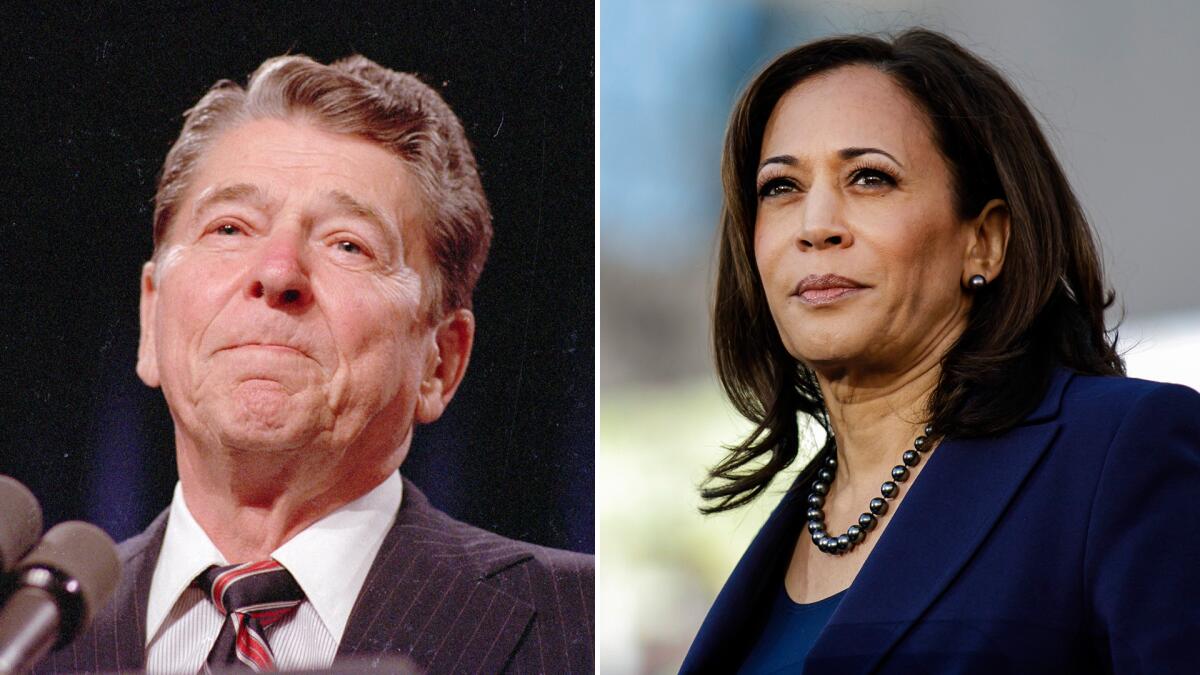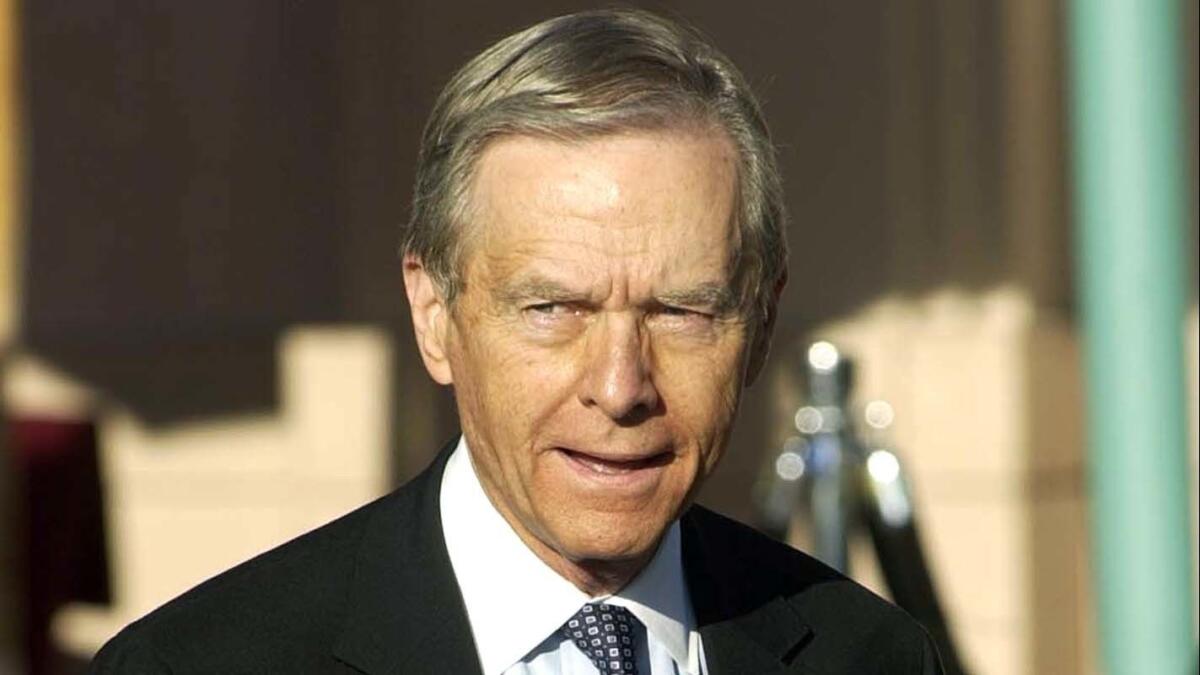In Kamala Harris, a sequel to Ronald Reagan?

- Share via
In 1980, former California Gov. Ronald Reagan was elected the nation’s 40th president. Blondie topped the music charts, the sequel to “Star Wars” packed movie theaters and Kamala Harris was a 16-year-old finishing high school.
Nearly four decades later, Harris is a leading candidate for the 2020 Democratic presidential nomination, the favorite in California’s March 3 primary and, as a U.S. senator, the state’s most serious White House contender since Reagan entered the Oval Office.
The differences are stark.
Reagan was a son of the American heartland, a California transplant, a Republican anointed by Southern California’s conservative establishment. Harris is a California native, the daughter of immigrants — her father from Jamaica, her mother from India — and a Democrat steeped in the liberalism of the San Francisco Bay Area.
Together, they bookend 40 years of dramatic political and demographic transformation in their home state (along with five more “Star Wars” sequels). In their own way, Reagan and Harris both embody the California of their time and, more broadly, changes across America.
Who’s in and who’s on the fence? »
The state that ushered Reagan to the White House was predominantly white and Republican-leaning, an arsenal of the Cold War and a hotbed of anti-tax fervor. The California that serves as Harris’ national springboard has more brown than white residents, is strongly Democratic and a leader in high-tech innovation, and has twice voted in recent years to pay more taxes.
“She’s everything he’s not and, in many ways, that’s what the state’s become,” said Mike Madrid, a GOP strategist in Sacramento, who has spent two decades fighting within the party to broaden its appeal, especially among the state’s burgeoning Latino population.
Harris, of course, has enjoyed nowhere near the political success of Reagan, who in addition to serving two terms as California governor twice captured the White House — the second time in a 1984 landslide of historic proportion.
She is a freshman in the Senate, after serving two terms as California attorney general and, before that, district attorney of San Francisco. Although Harris had an impressive start to her presidential campaign and places well in national polls, the Democratic race is just beginning as the field continues taking shape.
Before she even makes it to California’s early primary, and a hoped-for boost from home-state voters a year from now, Harris will have to perform well in contests in Iowa, New Hampshire, Nevada and, especially, South Carolina, where she is counting on strong support from its sizable African American electorate.
Still, on paper at least, Harris’ profile — a biracial woman from a state at the beating heart of the anti-Trump resistance — appears well-tailored to the mold of the Democratic Party heading into 2020, much as Reagan reflected, and indeed hastened, the changes that transformed the GOP and the nation in 1980.
In Reagan’s case it was a triumph of Sun Belt conservatism, grounded in a strong national defense, assertive foreign policy, promotion of “traditional family values” and aversion to big government programs and the taxes that finance them. Californians had spoken vehemently on the latter just two years prior, passing the property-tax-slashing Proposition 13, which spawned a nationwide taxpayer revolt and helped lift Reagan to the White House.
His appeal reached beyond Republicans to conservative Democrats, as it did in California, and not just because of his policies. “He had a charismatic quality. He was believable,” said Stuart K. Spencer, the strategist who helped elect Reagan governor and then president. “But the biggest thing, he was really a nonthreatening politician.”
The state’s electorate then was overwhelmingly white and the middle class thriving, thanks to the sturdy pillars of California’s economy: the defense, construction, agriculture and manufacturing industries.
But in the early 1990s, with the end of the Cold War, the defense industry contracted and California’s archipelago of military bases shrunk, dealing a serious blow to the economy, especially for those lacking a college education or the specialized skills needed to work in the growing fields of finance and high-tech.
Many white residents fled the state, quitting California for lower-tax neighbors like Arizona and Nevada, or seeking more conservative political climes, like Idaho and Texas. They were replaced in part by immigrants like Harris’ parents, drawn to California by its sterling university system, and others lower down the economic ladder, attracted by entry-level jobs in the agriculture and service industries.
Republican Gov. Pete Wilson managed to win reelection in 1994, thanks to a hapless opponent, his deft handling of several natural disasters and embrace of Proposition 187, a harsh-edged measure targeting illegal immigration and later mostly voided in court.
What followed was a slow unraveling of the state GOP.
Wilson’s support for Proposition 187, which sought to deny healthcare, education and welfare benefits to those in the country illegally, antagonized and energized Democratic-leaning Latinos, whose voting ranks swelled from the mid-single digits when Reagan became president to more than a quarter of eligible voters in November’s midterm election.

At the same time, the national GOP’s hard-line stance on issues like guns and immigration and the increased prominence of religious conservatism pushed moderate, live-and-let-live Californians away from the Republican Party, boosting Democrats to power and turning Reagan Country into a pale memory.
Forty years on, it is Harris who “represents the values and culture and demographics of the liberal Democratic state we’ve become,” said Mark DiCamillo, a nonpartisan pollster who has spent decades plumbing the opinions of California voters.
Harris ventures now to lead a national Democratic Party that has shifted decidedly leftward, its success built on a foundation of women, minorities and socially broad-minded young people. In short, a coalition that has come to greatly resemble California’s populace.
Seeded in the Golden State is the notion of destiny, a conceit its fertile land is where trends germinate and the future is first glimpsed. Indeed, changes that helped transform California from red to blue have since manifested elsewhere — in Nevada, Colorado, New Mexico.
Demographically, the country is headed in a similar direction. In 1980, nearly 9 in 10 voters were white. In 2020, nonwhites are expected to account for fully a third of eligible voters, the most ever.
There is no guarantee that Harris will be chosen as her party’s standard-bearer. Many of her positions — support for higher taxes on the rich, universal healthcare, debt-free college — are shared by fellow candidates, who differ only in their means of achieving those goals.
More significantly, there is the question whether Democrats, in moving so conspicuously from the center, are placing themselves out of step with a majority of voters.
William Frey, a demographics expert at Washington’s Brookings Institution, sees America in the long term looking increasingly like California does today. The question in the short term, he said, is “whether we have a big backlash against that kind of Democratic-minority-progressive type of coalition,” thus yielding Trump a second term.
The general election is 20 months off. Only if Harris wins her party’s nomination and, in November 2020, the White House will it be clear whether the state that produced President Reagan has yielded another — albeit very different — political sequel.
But for now, anyway, parts of the script have a familiar ring.
CALIFORNIA COUNTDOWN
How California’s early primary illustrates the state’s political inferiority complex
Democrats, facing a big candidate field, ask: Who can beat Trump?
California’s presidential primary: Here’s what you need to know
More to Read
Get the L.A. Times Politics newsletter
Deeply reported insights into legislation, politics and policy from Sacramento, Washington and beyond. In your inbox three times per week.
You may occasionally receive promotional content from the Los Angeles Times.











